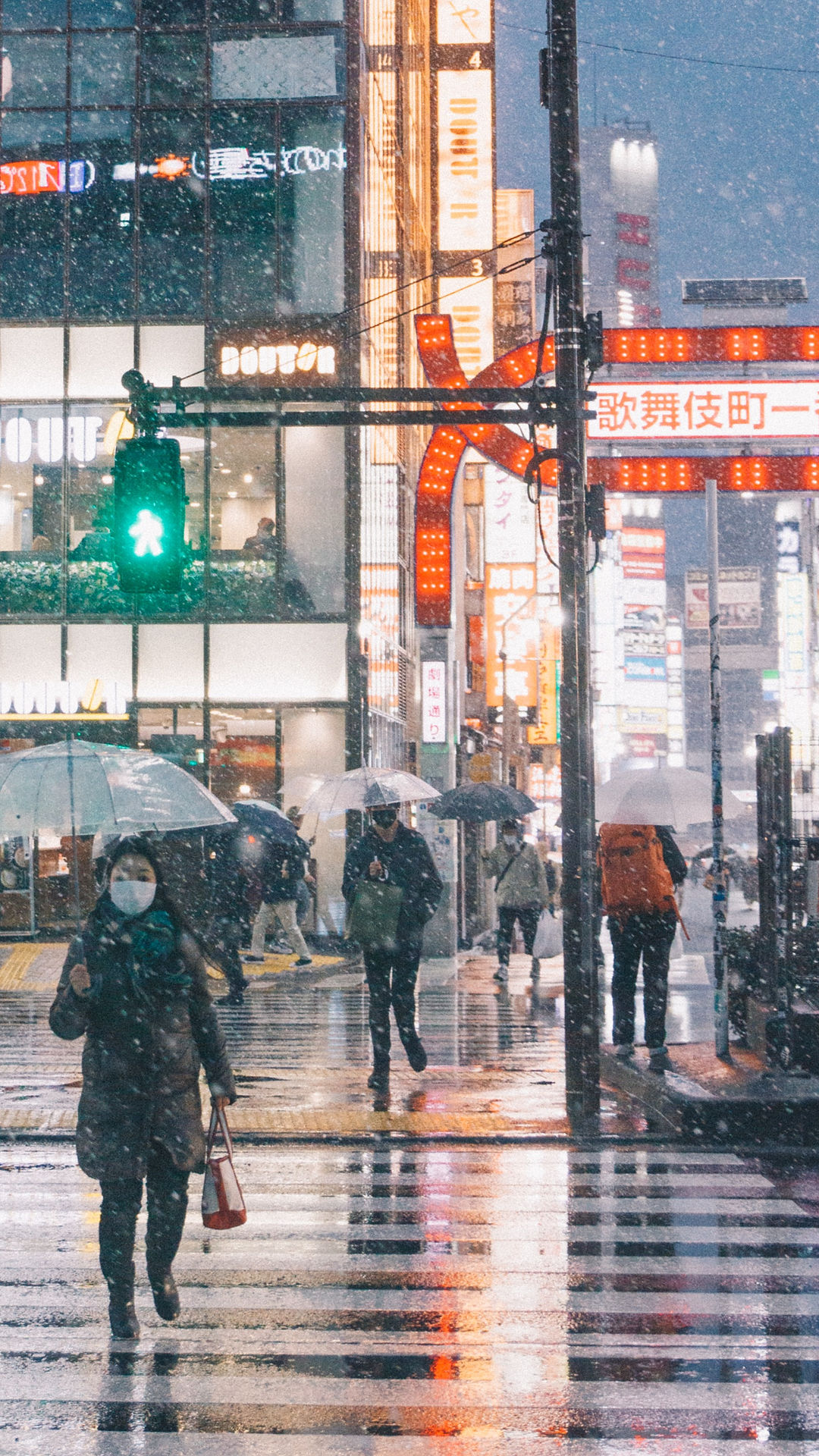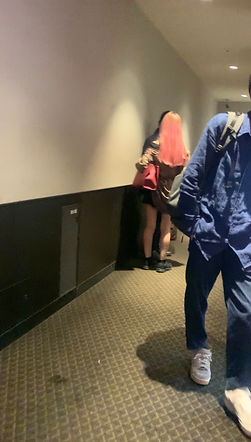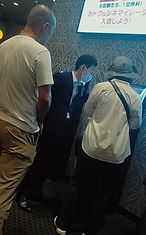
Space and Place
Toho Cinema
by Reo
This page explores the ways in which space and place of Toho Cinema allows for behaviours that become anomalies in Kabukicho due to its location and the types of people that visit the cinema.
“The strangeness lies in the fact that (persons) come from different face-to-face contexts . . . they come from different areas of conversation. They do not have a shared past, although their pasts have a similar structure” (Berger 1970:54)
Domains:
-
Comfort (Pillars, Insider Groups, Free Outsiders)
-
Privacy (Hallways, Corners & Walls)
-
Trust (Employees & Personal Space)
Introduction
Kabukicho contrasts itself from other urban places in more ways than one. Insiders and outsiders follow different social orders, thus leading to contrasting behaviours. When ______ argues that urbanites treat each other nothing more than strangers or objects, behaviours that have been observed within the Toho Cinema may indicate otherwise; that people tend to be specially aware and careful of strangers that are around them. In other words, it may stand to reason that both insiders and outsiders are aware of where each other comes from, thus using the space and place given to them for various reasons.
Comfort
Pillars & Lone Insiders
Within the cinema, it is common for insiders who come alone to stand around the pillar. As they gather around the pillar, all of them tend to look down at their phones in order to appear “occupied”, and thus, saving themselves from potential conversation with outsiders or strangers in general. This particular behaviour is exactly what Erving Goffman illustrates through his concept of “Dramaturgical” view of interaction. He focus on the tendency that persons have of being more concerned with how one appears, rather than what one actually is (Karp 2015; 91). Thus, people tend to be “actors” in a dramaturgical sense.
At the same time, however, as mentioned in Personal Identity, lone insiders tend to be aware of the presence of outsiders around them. Hence, many of them have the tendency of looking down at their phones and periodically look around in an attempt to look as if they are with someone. This particular behaviour is believed to avoid any potential of being approached by or talked to from a stranger. As (Karp 2015; 90) identifies, urbanites appear to be avoiding interactions; keeping themselves away from potential direct communication. Moreover, they tend to hide behind newspapers as a way to avoid making eye contacts which may invite communication (Karp 2015; 90).
Lone insiders seen standing around the pillar in the Cinema


A group of insiders moving very closely to each other

A group of family seen distanced very close together
Groups Stick Together
It has been observed that the wide space of the Toho Cinema not only allows for easier maneuvering, but also for big groups to form within. Therefore, within the place, groups of insiders from small to large is evident. The point worth considering in this particular section, is the fact that many of the group members almost leave no distance between each other whether it be standing at one spot or moving through the area. This particular behaviour may be unconscious, but stems from their instinct for comfort and protection from outsiders. Thus, in contrast to lone insiders who do not have others who could protect them and therefore use pillars, those in groups tend to use each other for sense of comfort and protection.
Similar evidence applies to groups of families as well. Parents equally appear to be aware of the presence and behaviour of outsiders, which explains their instruction to their children to “stay close” while making their way through the space. This pattern is seen especially for the children, as Kabukicho is best known for late-night adult activities, which therefore, makes the presence of children a rare sight, much less families. However, because the cinema is located specifically in the place of Kabukicho, it leads to contrasting behaviours compared to cinemas in other urban places, which sees people’s natural instincts being stimulated for protection and comfort.
As Insiders navigate their way through the place in close groups, they are theoretically putting trust while also doubting the strangers around them. To persons, others around are considered as strangers, and any social interaction with each other can come with a risk; the risk of the conversation “going awry” (Karp 2015; 94). However, as Karp (2015, 91) also argues, social interaction can be more than verbal communication. When this is considered, we may argue that groups maintaining close distance as they are in the cinema, are doubting whether it is the safest strategy, but at the same time, putting trust into strangers to stay away.
Free Movements of Outsiders
The contrast that can be drawn between insiders and outsiders in terms of their behaviour is their intentions as well as movements. Many outsiders are seen coming in to the cinema, walk around, then leave. Thus, the open space of the cinema allows for free movements and behaviours that are one of the many anomalies of Kabukicho.
As observed within the cinema, insiders tend to visit the cinema for one objective: to watch movies. Thus, insiders are seen lining up at snack bars and ticket booths, while some other are seen standing at certain spots as they wait for their movies. However, outsiders tend to visit the cinema for unknown reasons, as many of them come in and out of the cinema without anyone accompanying them. More specifically, outsiders tend to walk around the whole space as if to be looking for someone before finally exiting the place alone once again.
Another behaviour or movement that can be observed among the outsiders is staring at insiders in the cinema. As Berger (1970: 54) states, people in an urban place consists of those who come from different face-to-face contexts. In other words, each bring their own personalities, experiences, and possibly, different interpretations of situations and places. Hence, when also applying Goffman’s dramaturgical sense of interaction, the difference in interpretation within situations and the behaviours that stem from it give each other meaning. People are constantly in the process of defining and redefining the action of one another (Karp 2015; 91). Thus, in Alfred Schutz’s words: “the cultural pattern of the approached group is to the stranger not a shelter but an adventure, not a matter of course but a questionable topic of investigation…” (Schultz 1960; 104).

An outsider seen mysteriously walking around the Cinema

An outsider seen staring at insiders for a long period of time

Outsiders using the hallway to have private conversation
Privacy
Hallways
The spaces of hallways within the cinema can be turned into a place for private interactions. Such is the case most commonly seen among outsiders.
The cinema provides a wide open space for multiple large groups and free movements. While the majority of insiders are seen communicating with each other within the open space, outsiders tend to protect their privacy by moving their conversations in hallways where not many people are present. However, they tend to disperse as they see a stranger getting close or walking near them.
This particular attempt of Outsiders staying out of mass people’s field of sight to have conversations may be connected to Goffman’s point of individuals being aware of how they present themselves as well as the risk of social interaction from strangers. In Karp’s words: “Clearly, the way that we conduct ourselves in interaction is a function of the degree of intimacy that exists between ourselves and others” (Karp 2015; 93). Therefore, it would stand to reason that because both Insiders and Outsiders see each other as strangers with no intimate relations, their own personal spaces are being heavily protected in order to avoid any awry social interactions.
Corners & Walls
People crouching or sitting near walls or corners are common sights within the place of Kabukicho. Hence, this is also evident within the place of the Toho Cinema.
Majority of the people within the place are usually gathered in lines waiting for the snack bar, the pillars or the tables that are lined up in the center of the room. Thus, hallways (as mentioned previously) and walls are spaces where there tend to be less people. In such spaces, few people tend to use it for comfort and safety by putting some distance between themselves and strangers who they share the place with.
In addition, as the image shows, the parallels that can be drawn between the behaviour of the people crouching near the wall and those standing by the pillars (earlier image), is that they all present themselves as “occupied”. In other words, as Karp states it: “In anonymous urban situations they seem to avoid one another, closing themselves off from direct communication” (Karp 2015; 90). Hence, once again, direct communication is being shut out as people hide behind their phones.

People seen crouching down beside the wall
Trust
Employees & Personal Space
The relationship between Insiders and the Employees in the cinema that is being stimulated by the wide-open space is also an aspect worth considering.
The cinema provides a wide-open space that allows for a clear view of the strangers that share the place. Most notably, employees can often be seen standing at the edge of the place, and looking across at the Insiders. In this case, employees may be looking for an Insider who appear to be troubled and in need of help.
In previous sections, we established the fact that individuals do not allow any strangers into their personal space. However, employees appear to be an exception. For instance, few insiders who need help operating the ticket machines would call the employees, where they would get very close to them. However, it is also important to note how the employees tend to put on a euphoric expression, while lowering their height as if they are about to bow. Thus, if we once again make connections with Goffman’s dramaturgical concept, it may be reasonable to state that employees present themselves as “nice and harmless” persons, which builds more trust and comfort for the Insiders.

An employee looking across the room

An employee entering one’s personal space

An employee within a personal space whilst offering help
.png)
Different Levels of Space of persons
Conclusion
Urban places includes people of contrasting backgrounds and experiences. Thus, arises the difference in interpretation of scenarios and people. Persons become strangers in the eyes of each other, which leads to the potential risk that may arise from social interaction. Therefore, social interaction with strangers are shut out, while only those who one is intimate (or has any relations with) are considered to be within the persons’ intimate space. However, people such as employees are considered to be exceptions, as persons may view them as more trustworthy than strangers, since they are those that implement and maintain social order within the place. However, the overall pattern that is evident within the cinema is people’s protectiveness of themselves from those around; and the wide-open place of the cinema provides multiple spaces for protection and safety to be achieved.
Look at the next page to explore how both Insiders and Outsiders follow social order:
Sections
toho cinema
.png)